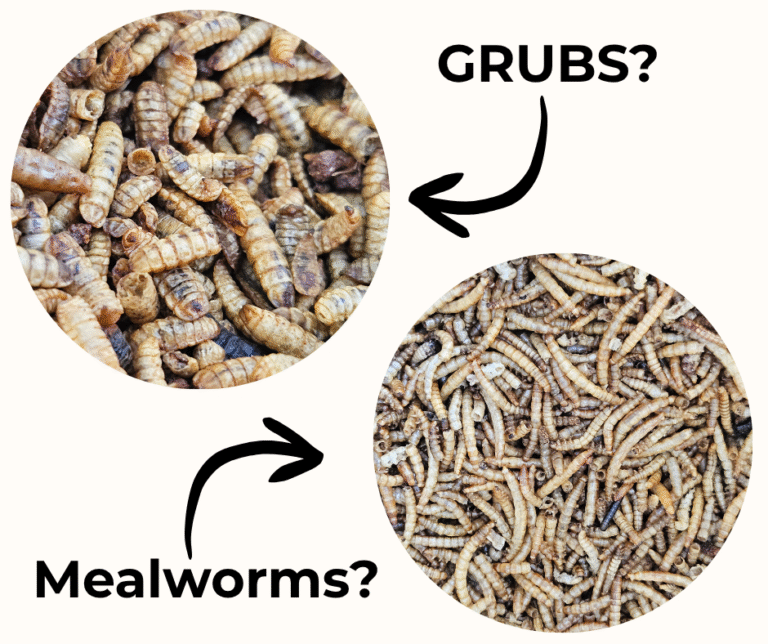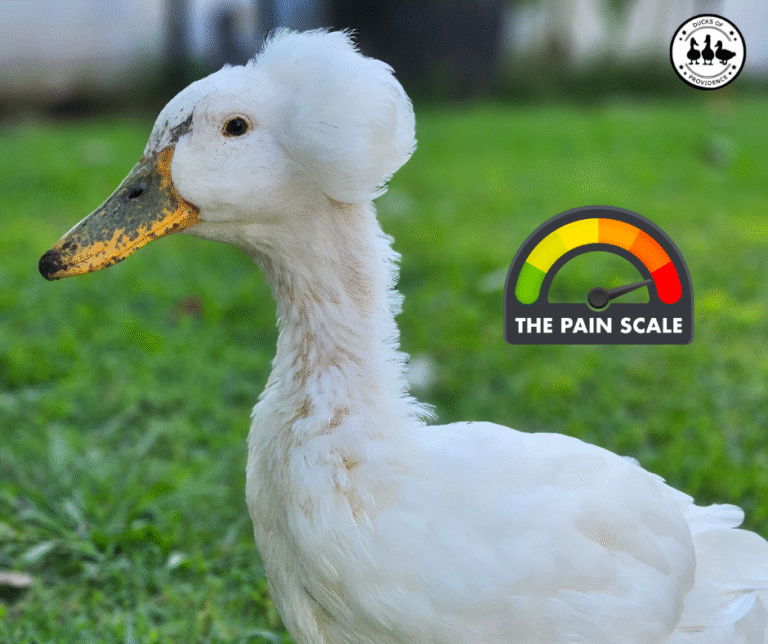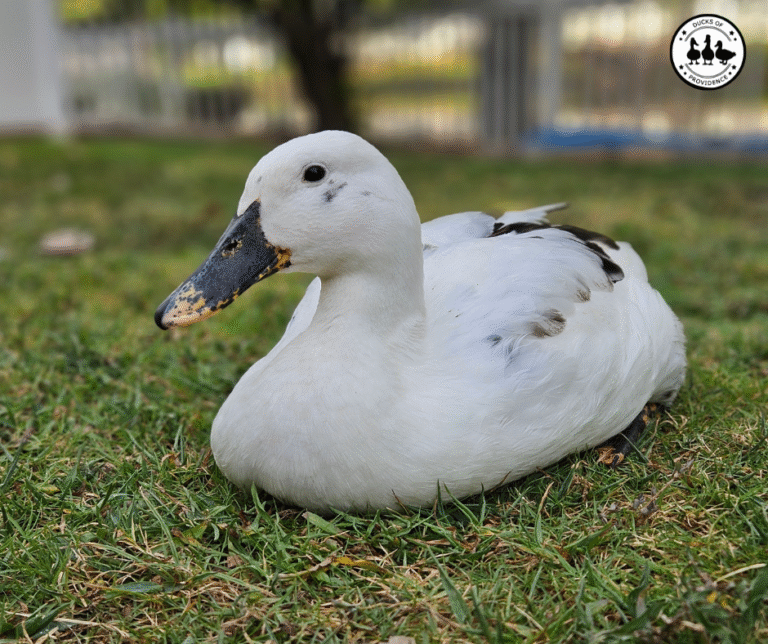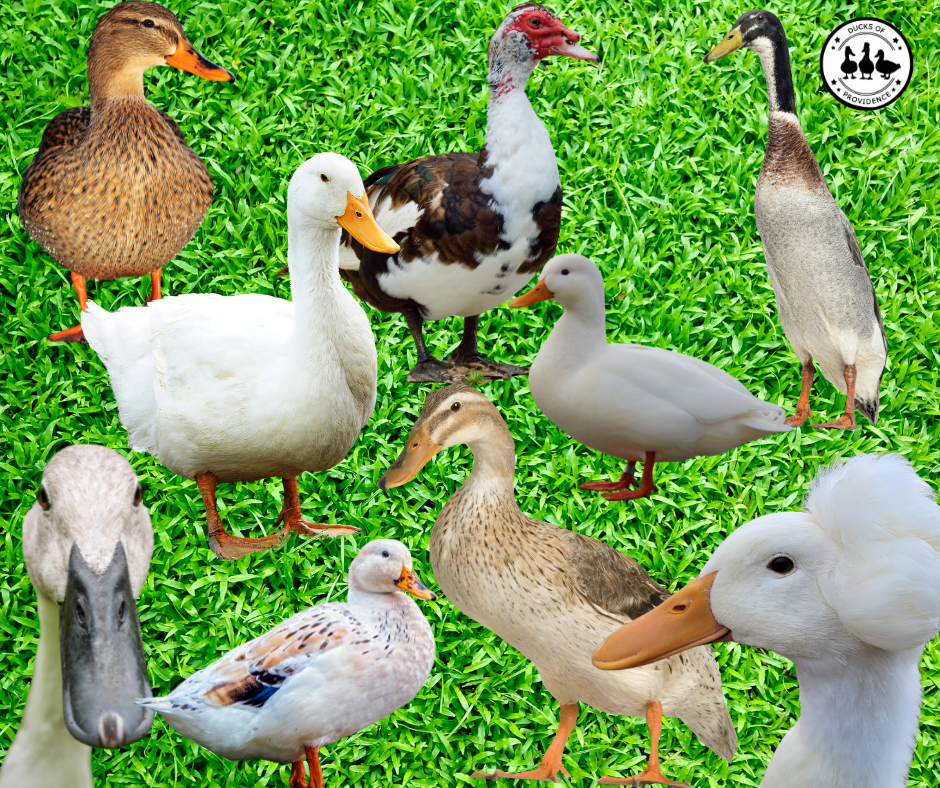
Ultimate Duck Breed Comparison Guide: Find the Right Duck for Your Flock
If you’re wondering which duck breed is best for your backyard or pet flock, this duck breed comparison guide is the perfect place to start. With so many breeds available—each with their own personalities, egg-laying habits, and care needs—it can be overwhelming to decide which one is right for you.
In this post, we’ve compiled a detailed comparison table of popular duck breeds commonly kept as pets or for small-scale egg and meat production. From tiny, talkative Call Ducks to the calm, heavy-laying Welsh Harlequin, we cover it all. You’ll find key traits like size, average weight, temperament, egg production, cold hardiness, and more—plus a short summary of each breed below.
Whether you’re new to duck keeping or looking to expand your flock, this guide will help you make an informed choice and explore the wonderful diversity of domestic ducks.
Ducks of Providence is free, thanks to reader support! Ads and affiliate links help us cover costs—if you shop through our links, we may earn a small commission at no extra cost to you. Thanks for helping keep our content free and our ducks happy! 🦆 Learn more
Breed Overview
| Breed | Size (Weight) | Egg Production | Temperament | Male vs. Female Differences | Primary Purpose | Hardiness |
|---|---|---|---|---|---|---|
| Ancona | Medium (6–6.5 lb) | 210–280/year | Friendly, active | Drakes: solid heads; hens: mottled | Eggs, Pets | Cold-hardy |
| Aylesbury | Heavy (9–10 lb) | 35–125/year | Calm, docile | Drakes larger, pink bill | Meat | Moderate |
| Buff Orpington | Medium (7–8 lb) | 180–245/year | Gentle, mellow | Drakes: more upright stance | Eggs, Pets | Moderate |
| Call | Bantam (1.5–2 lb) | 100–150/year | Social, loud | Drakes quieter | Pets, Exhibition | Moderate |
| Cayuga | Medium (6–8 lb) | 100–150/year | Calm, curious | Iridescence fades with age | Eggs, Meat, Pets | Cold-hardy |
| Crested | Medium (6–7 lb) | 100–130/year | Friendly, quirky | Crest varies; not sex-linked | Ornamental, Pets | Moderate |
| Duclair | Medium (6–7.5 lb) | 80–150/year | Calm, good foragers | Drakes heavier | Meat, Eggs | Cold-hardy |
| Indian Runner | Light (3.5–5 lb) | 250–300/year | Energetic, upright | Tall, upright stance in both sexes | Eggs | Moderate |
| Khaki Campbell | Light (4–5.5 lb) | 280–320/year | Alert, productive | Drakes have curled tail feather | Eggs | Moderate |
| Magpie | Medium (5.5–6 lb) | 220–290/year | Active, curious | Markings vary | Eggs, Ornamental | Cold-hardy |
| Mallard | Small (2–2.5 lb) | 50–100/year | Shy, flighty | Drakes: green head; hens: brown | Ornamental, Pets | Cold-hardy |
| Muscovy | Large (7–15 lb) | 60–120/year | Quiet, independent | Drakes much larger, caruncles | Meat, Brooding | Heat-tolerant |
| Pekin | Heavy (8–11 lb) | 150–200/year | Friendly, loud | Drakes deeper quack | Meat, Pets | Cold-hardy |
| Rouen | Heavy (9–11 lb) | 100–150/year | Calm, docile | Drakes: vivid colors like Mallards | Meat, Ornamental | Cold-hardy |
| Saxony | Heavy (8–9 lb) | 200–250/year | Gentle, active | Drakes: blue-gray heads | Dual-purpose | Cold-hardy |
| Shetland | Small (3–4 lb) | 100–150/year | Hardy, calm | Similar to Mallard markings | Eggs, Heritage breed | Cold-hardy |
| Silver Appleyard | Heavy (8–9 lb) | 200–270/year | Outgoing, alert | Drakes: darker markings | Eggs, Meat | Cold-hardy |
| Silver Bantam | Bantam (2–2.5 lb) | 60–100/year | Active, bold | Small size, crested line available | Ornamental, Pets | Cold-hardy |
| Swedish (Blue/Black) | Medium (6.5–8 lb) | 120–180/year | Calm, reserved | Drakes: solid head color | Eggs, Ornamental | Cold-hardy |
| Welsh Harlequin | Light (4.5–5.5 lb) | 250–300/year | Gentle, social | Sex-linked color differences | Eggs, Pets | Moderate |
| White Layer | Light (4.5–5 lb) | 290–330/year | Productive, alert | Developed for high egg yield | Eggs | Moderate |
Ancona
Ancona ducks are medium-sized, hardy birds known for their friendly personalities and unique mottled feather patterns. They’re excellent foragers and enjoy exploring their environment, making them great for free-range setups. Anconas are reliable layers, producing 210–280 colorful eggs per year in shades of white, blue, or green. Their calm nature and charming appearance make them a favorite among pet duck owners. They’re also considered a rare heritage breed in need of conservation.
👉 Read our full Ancona Duck profile →
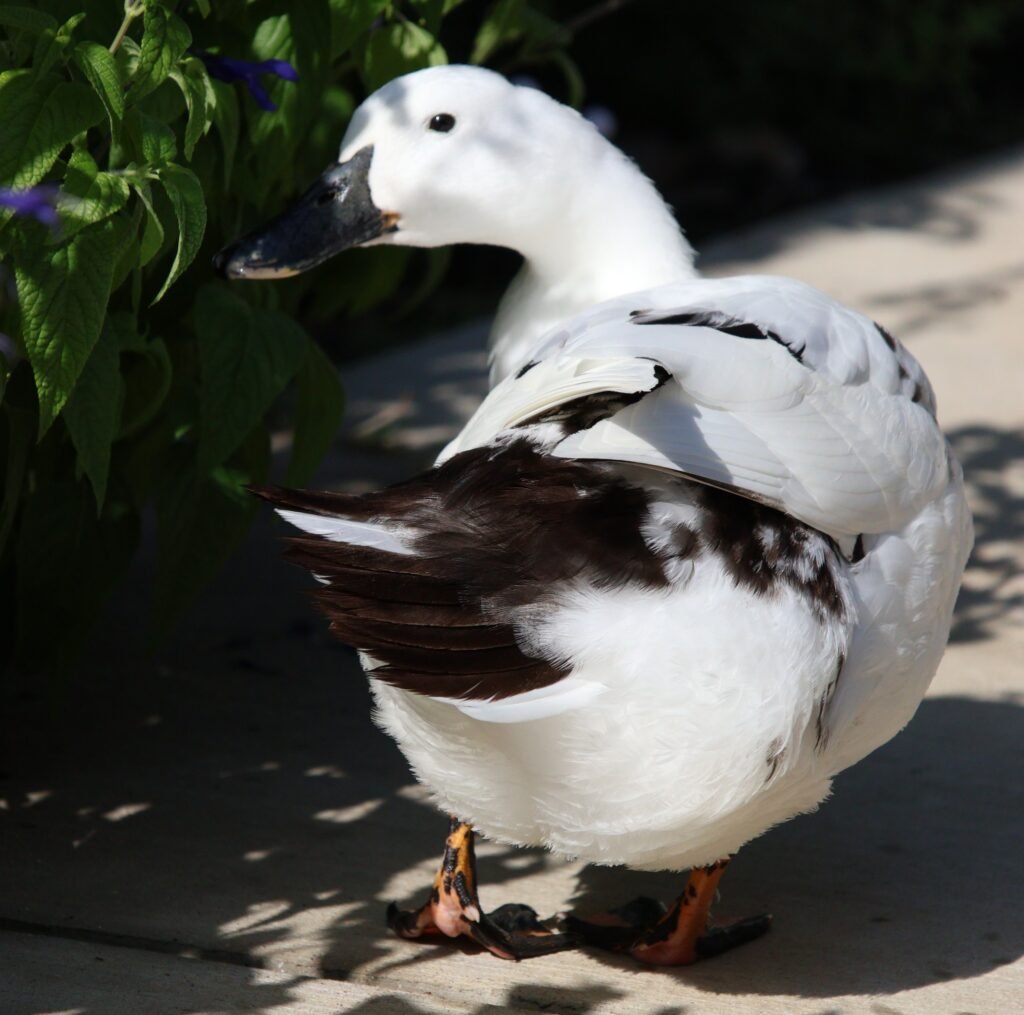
Aylesbury
The Aylesbury is a large, traditional English meat duck known for its flavorful flesh and calm temperament. Males average around 10 pounds, females around 9, and young birds reach market weight in 7 to 9 weeks when fed a concentrated diet. They have pure white plumage, white skin (unlike most ducks), orange legs, and a distinct long, straight pinkish bill. Egg production ranges from 35 to 125 eggs per year, with some utility strains performing well under good care. Aylesburies are critically endangered, and conservation breeders are needed to preserve this gentle and historic breed.
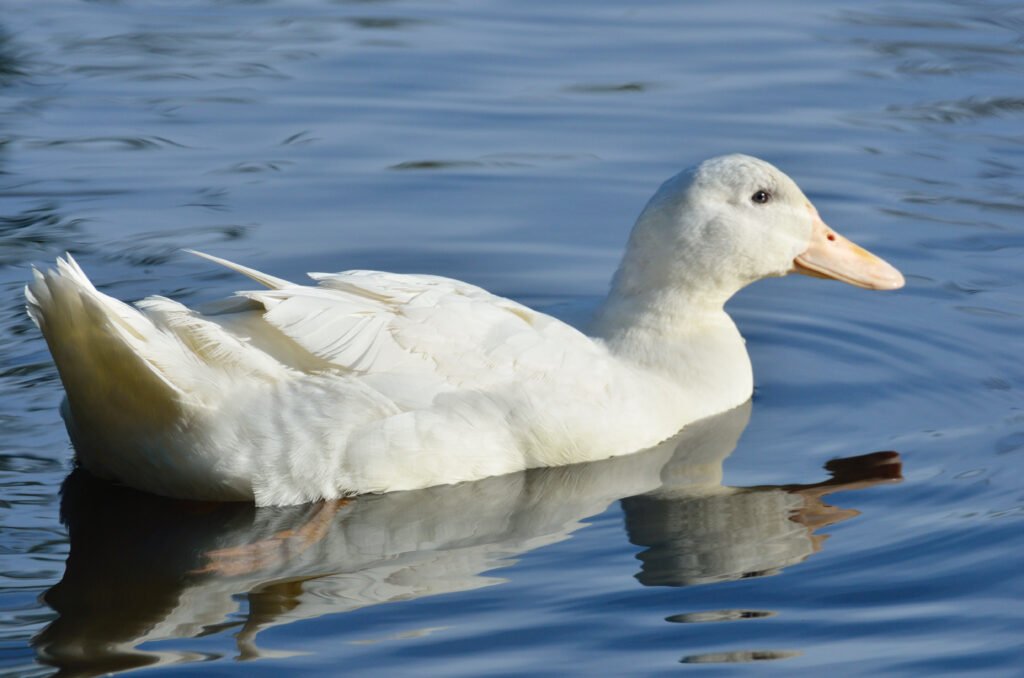
Buff Orpington
Buff Orpington ducks—also known simply as “Buffs”—are beautiful golden-colored birds with a gentle and friendly temperament. They were originally developed in the early 1900s for dual-purpose use, producing around 180–245 eggs per year and offering a good meat yield. Buffs are known for being calm, making them great companions for families or smaller flocks. Their warm feather color is especially striking in the sun. These ducks thrive in moderate climates with access to clean water and shade.
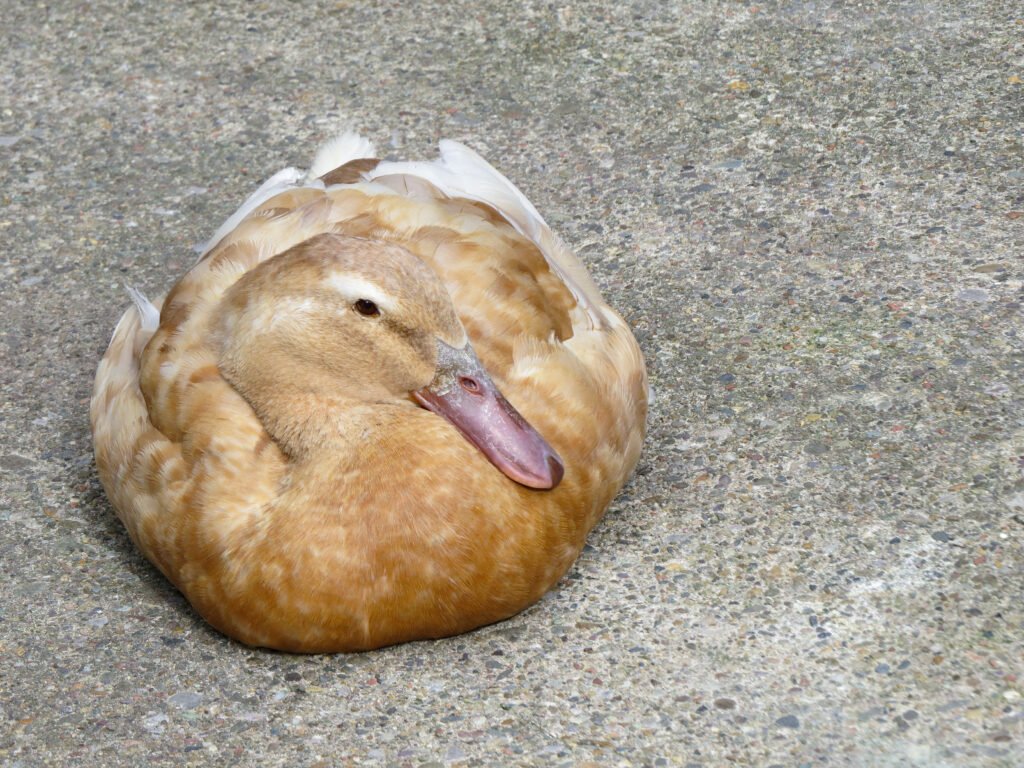
Call Duck
Call Ducks are the smallest domestic duck breed and are famous for their loud voices and adorable appearance. Originally used as decoys by hunters, today they are popular as ornamental pets and exhibition birds. They lay around 100–150 small white eggs per year and require secure housing due to their excellent flying ability. Despite their size, they have big personalities and are very social. Their high-pitched quacks, especially from females, are part of their charm—and their name.
👉 Read our full Call Duck profile →
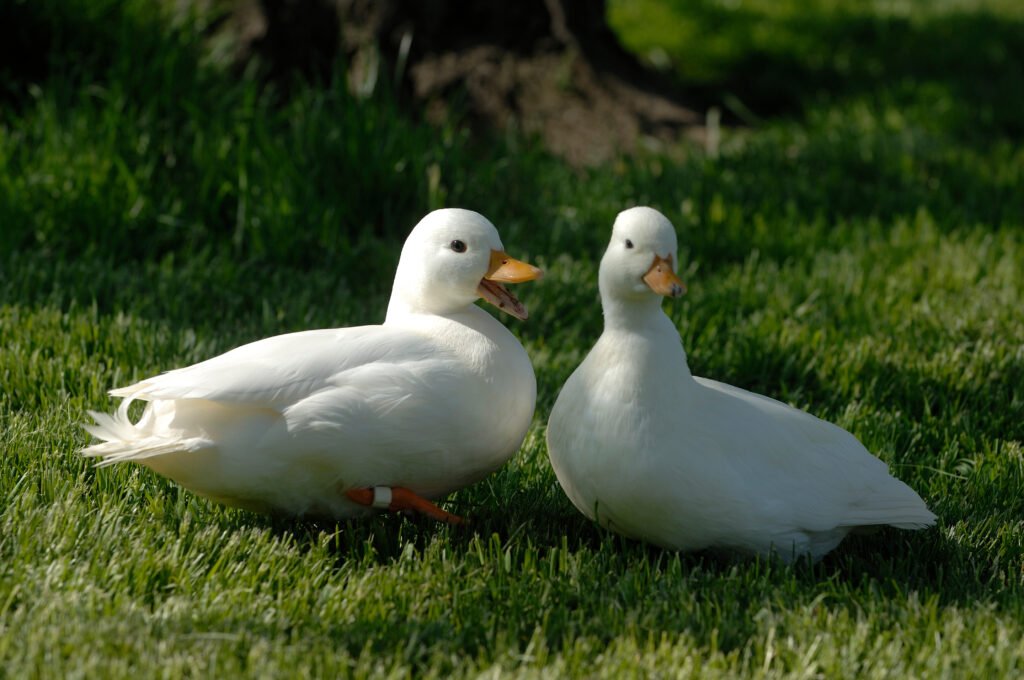
Cayuga
Cayuga ducks are medium to large birds with stunning black plumage that shimmers green and purple in the sunlight. They lay between 100–150 eggs per year, starting out black or charcoal and gradually fading to white later in the season. Cayugas are calm, quiet, and cold-hardy, making them ideal for backyard flocks in northern climates. They are also known for being more tolerant of close human contact. Over time, older birds may develop white feathers, which is completely normal.
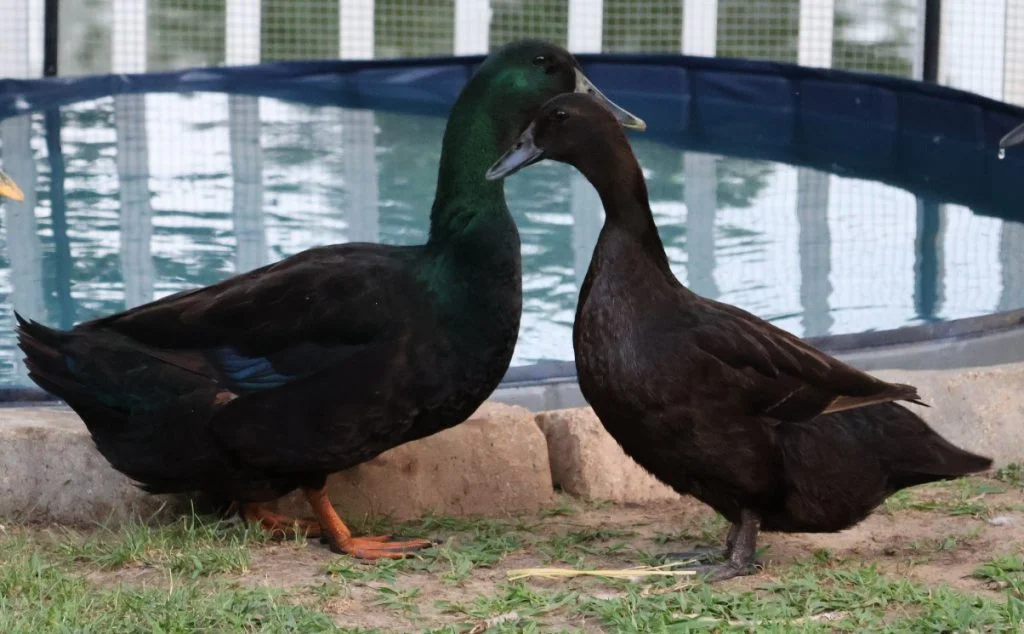
Crested
Crested ducks are instantly recognizable by the fluffy feather “pom-pom” on top of their heads, a result of a genetic mutation. They’re medium-sized, friendly, and do well in mixed flocks, though the crest trait can come with health risks if both parents carry it. These ducks lay around 100–130 eggs per year and are often kept more for their ornamental value than production. Their quirky appearance and sociable nature make them popular with families and hobby keepers. It’s important to source Crested ducks from responsible breeders to reduce the risk of birth defects.
👉 Learn more about Crested Ducks →
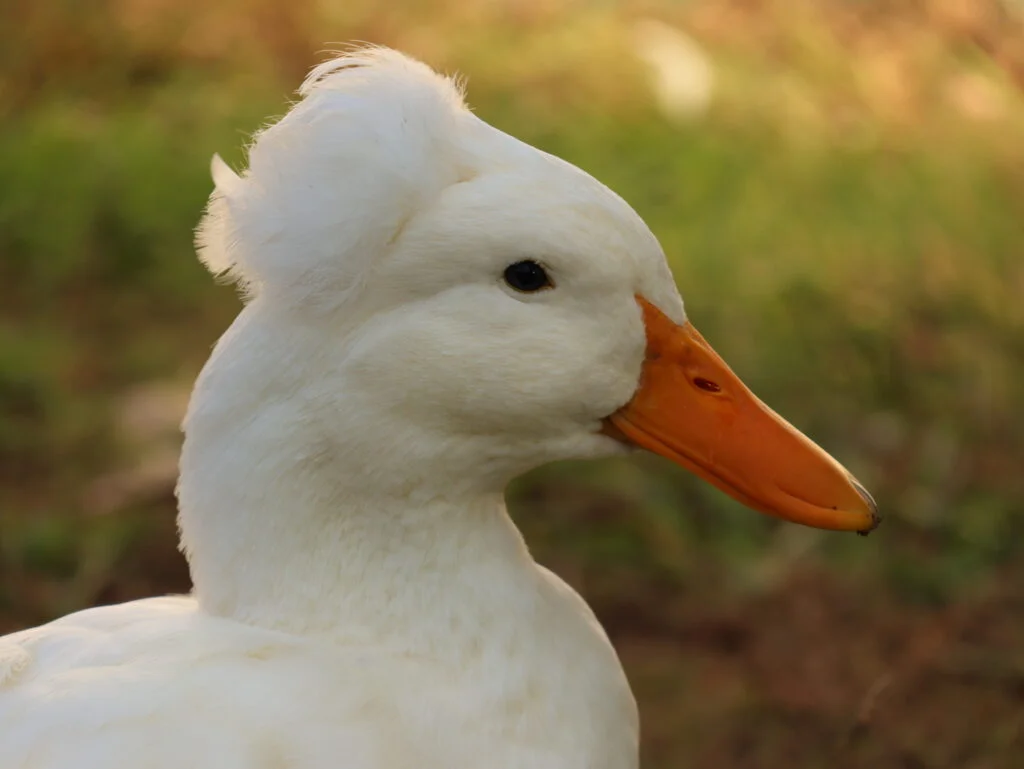
Duclair
Duclair ducks are a French heritage breed known for their dual-purpose qualities—both flavorful meat and respectable egg production. They have striking plumage, often in black or blue with a white bib, and are excellent foragers. Laying between 80–150 eggs per year, they tend to be calm and adaptable, making them a solid choice for small farms or backyard flocks. Duclairs are considered critically endangered and are part of some breed preservation efforts. They are well-suited for colder climates and natural environments.
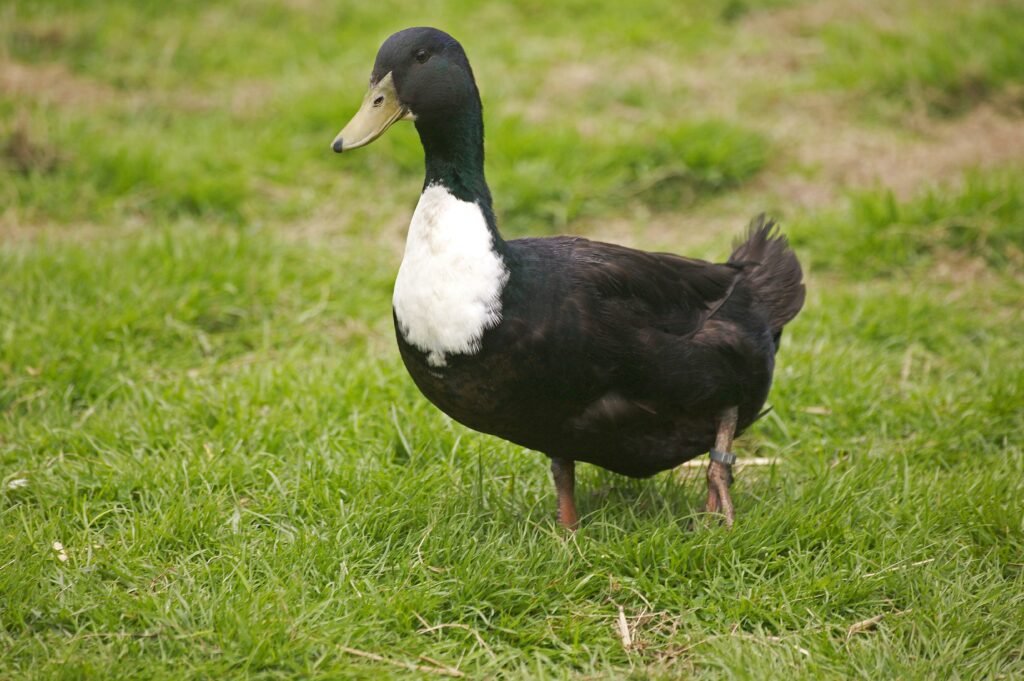
Indian Runner
Indian Runners are unique in both posture and behavior—they stand upright like penguins and are constantly on the move. These light-bodied ducks are among the best layers, producing 250–300 eggs per year in a variety of shell colors. Runners are known for their foraging skills, nervous energy, and comical running gait rather than waddling. While they are less likely to go broody, they thrive in flocks and enjoy room to roam. They come in many color varieties, from white to fawn-and-white to penciled.
👉 Read our Indian Runner Duck profile →

Khaki Campbell
Khaki Campbells are one of the most prolific egg-laying duck breeds, with hens laying an impressive 280–320 eggs per year. These light-bodied ducks are highly active, a bit shy, and well-suited to free-range environments. Their khaki-brown coloration provides great camouflage, and they’re known for being hardy and adaptable to a range of climates. Khaki Campbells rarely go broody, which is great for consistent egg production. They’re ideal for keepers who prioritize eggs over companionship.
👉 Explore Khaki Campbell facts →
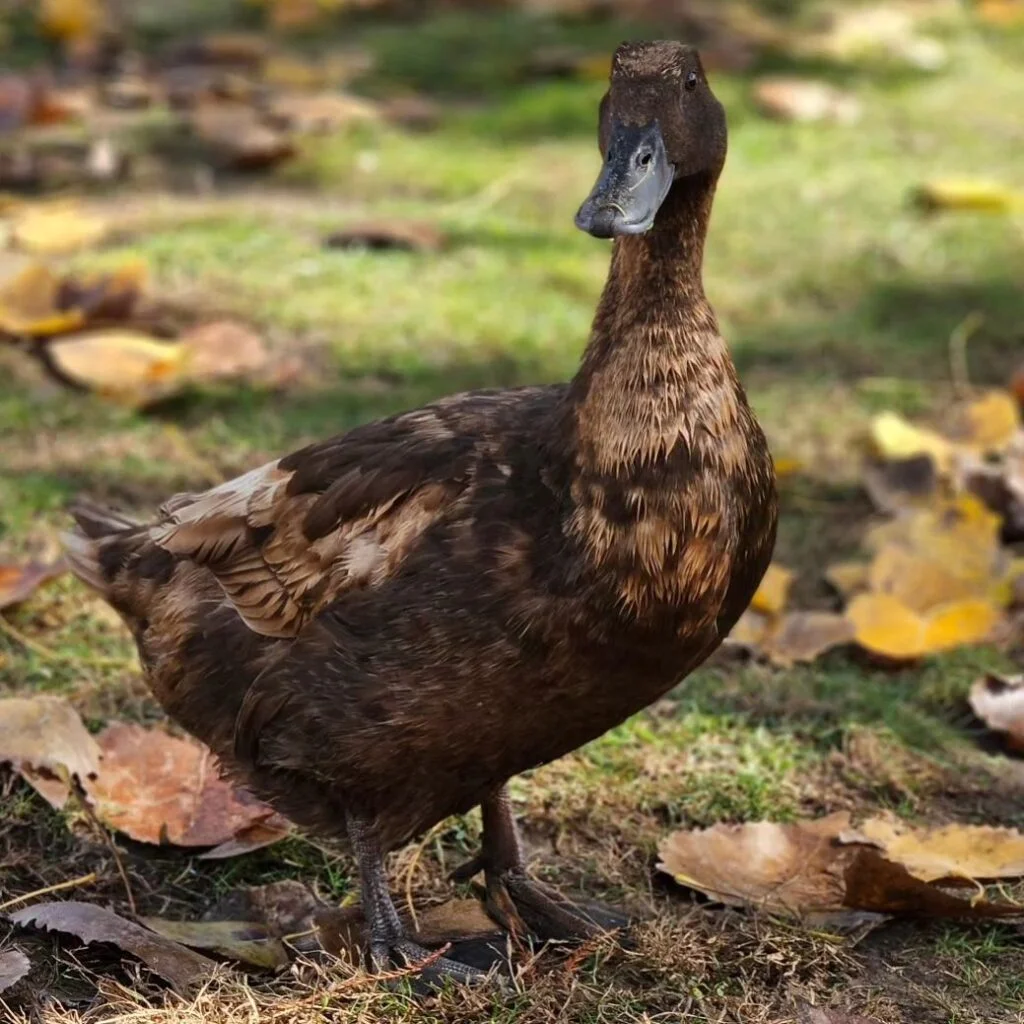
Magpie
Magpie ducks are medium-sized and beautifully marked in black and white (or blue and white), resembling the namesake bird. They are productive layers, offering 220–290 eggs per year, and are calm, active, and easy to handle. Their markings can vary between individuals, often with a dark cap on the head and spots on the back. Magpies are a good choice for those who want both egg production and ornamental beauty. They’re also fairly rare and considered a heritage breed.
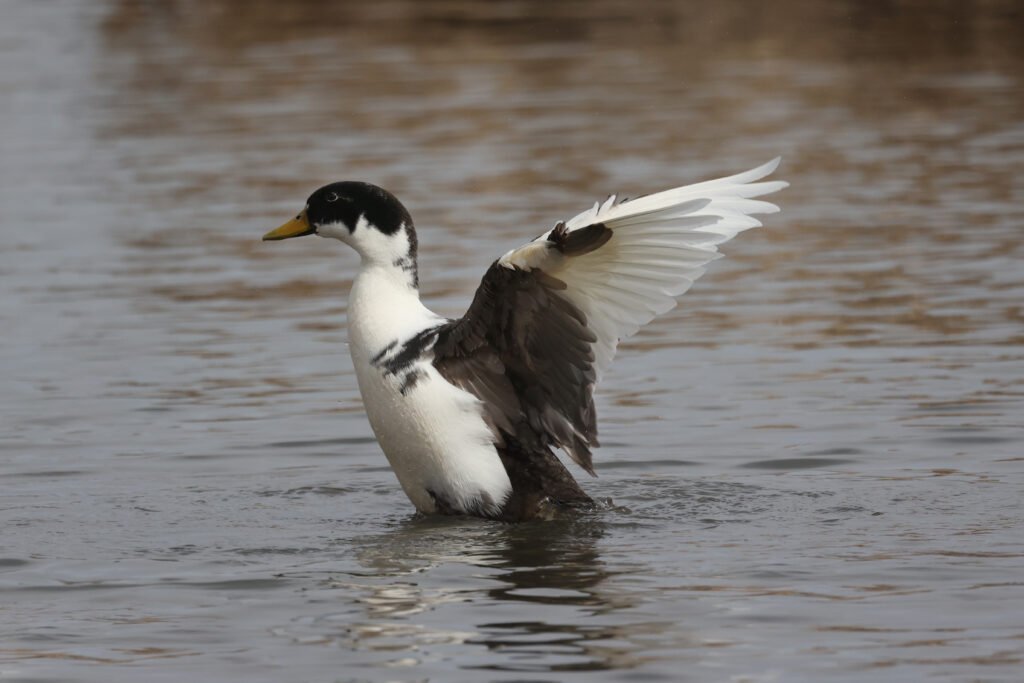
Mallard
Mallards are the wild ancestors of most domestic duck breeds and are known for their natural beauty and flying ability. Males have striking green heads and curled tail feathers, while females are mottled brown for camouflage. They lay about 50–100 eggs per year in captivity and tend to be more skittish than domesticated breeds. Mallards are small and agile, so they require secure enclosures if kept as pets. In many areas, owning Mallards may require a permit due to their status as native wildlife.

Muscovy
Muscovy ducks are a unique, non-mallard species known for their caruncles (red facial growths), quiet demeanor, and strong flying ability. They’re larger than most ducks—especially the drakes—and are excellent for natural pest control since they eat flies, mosquitoes, and even small rodents. Egg production is modest (60–120 eggs/year), but they are excellent brooders and attentive mothers. Muscovies are heat-tolerant, making them well-suited to warm climates, and they roost like chickens. They don’t quack, but instead hiss or make soft noises.
👉 Read our Muscovy Duck profile →
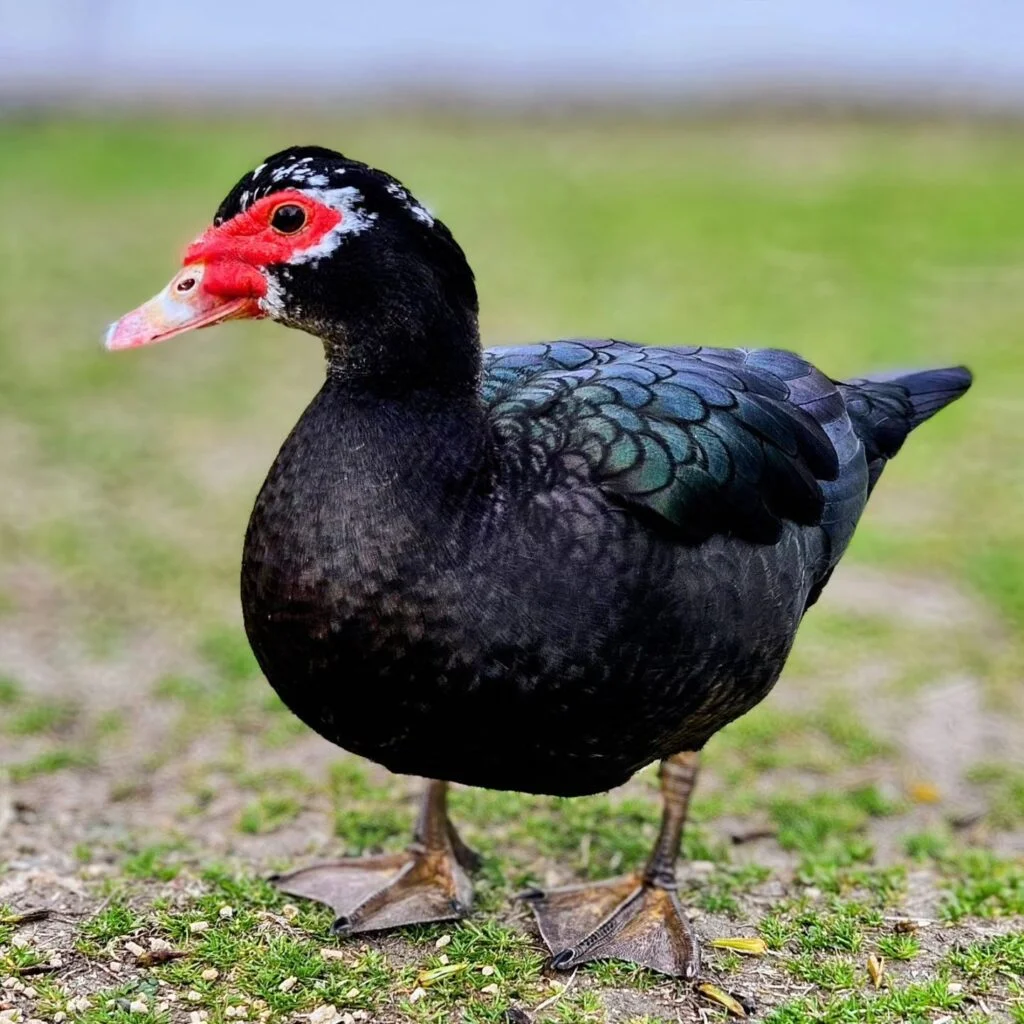
Pekin
Pekin ducks are one of the most recognizable domestic duck breeds with their bright white feathers and upright, heavy-set bodies. They’re friendly, fast-growing, and lay 150–200 large white eggs per year. Pekins are often used in commercial meat production, but they also make affectionate and hardy pets. Because of their size, they don’t fly and are prone to weight-related health issues if not properly managed. Jumbo Pekins especially need monitored diets and soft ground to avoid foot problems.
👉 Explore Pekin Duck care and traits →
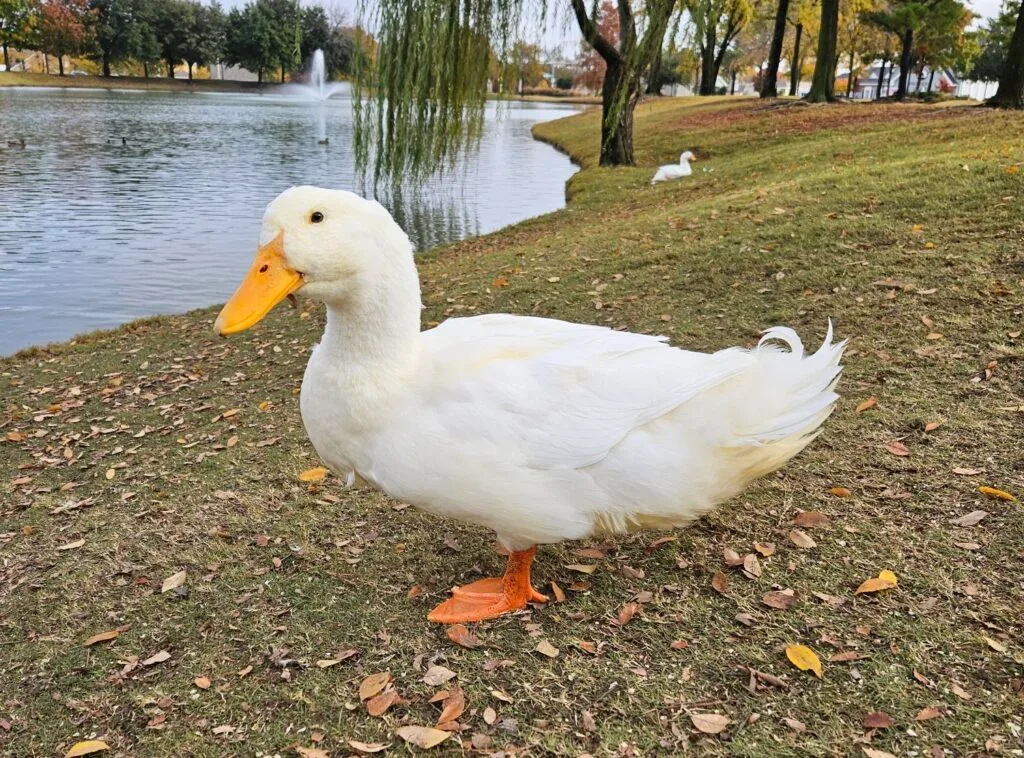
Rouen
Rouen ducks resemble large Mallards but are much heavier, making them a popular dual-purpose breed. They lay about 100–150 eggs annually and are typically kept for meat or exhibition rather than high egg output. Rouens are docile, slow-moving, and don’t fly, which makes them well-suited to backyard setups. Their rich coloration and calm nature make them a beautiful and manageable addition to the flock. However, their size means they require extra attention to foot health and clean housing.
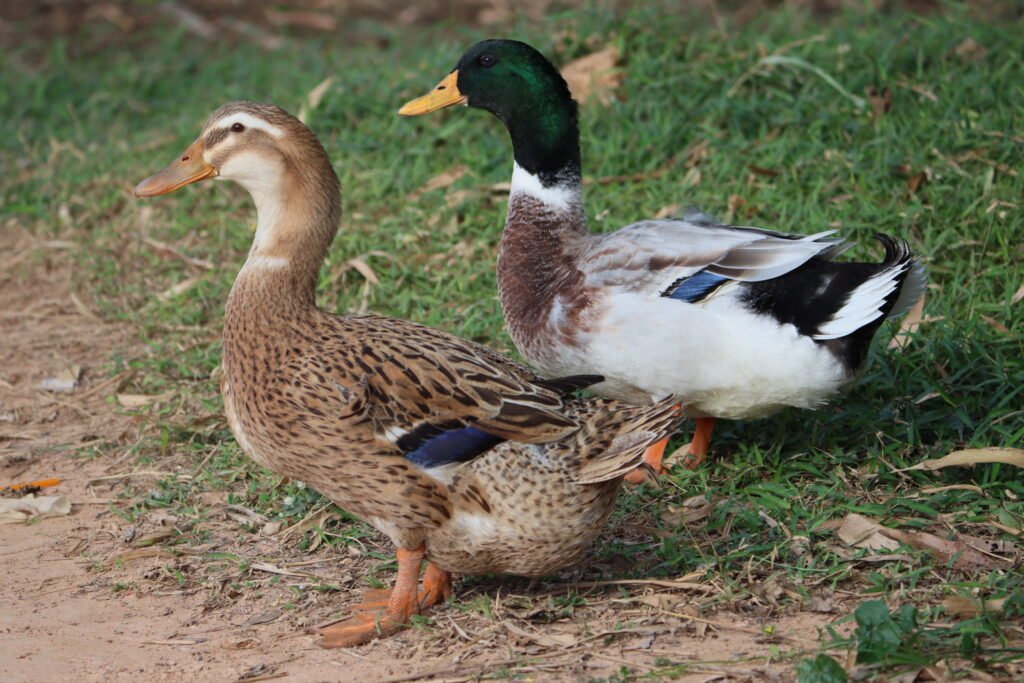
Saxony
Saxony ducks are a large, attractive breed developed in Germany for both meat and eggs. They produce around 200–250 eggs per year and have soft buff, blue, and cream plumage with a classic upright posture. Gentle and calm, Saxonies enjoy human interaction and make great pets for families or mixed flocks. They are good foragers and relatively low-maintenance but benefit from plenty of space to roam. Drakes have a slate-blue head and chestnut breast, while females are a warm buff color.
👉 Read our Saxony Duck profile →

Shetland
The Shetland duck is a small, critically endangered breed—one of the rarest duck breeds in the world. Originating from the Shetland Islands of Scotland, drakes average 4.4 pounds and ducks around 4 pounds, with a compact build and striking dark plumage. They are excellent foragers, very cold-hardy, and known for their calm, friendly nature. Hens lay about 150 large eggs per year, often white or grey, and are likely to go broody. Their iridescent black feathers and unique bill and foot coloring make them a valuable addition to conservation-minded flocks.
Silver Appleyard
Silver Appleyards are large, dual-purpose ducks known for their excellent egg-laying (200–270 eggs/year) and flavorful meat. They are friendly, alert, and active, often enjoying human interaction and foraging. Their beautiful silver, white, and chestnut feathering makes them popular in exhibition circles as well. Drakes have bold, dark markings while females are lighter with subtle penciling. They do best with access to clean water and plenty of space to roam.
👉 Silver Appleyard Duck Guide →
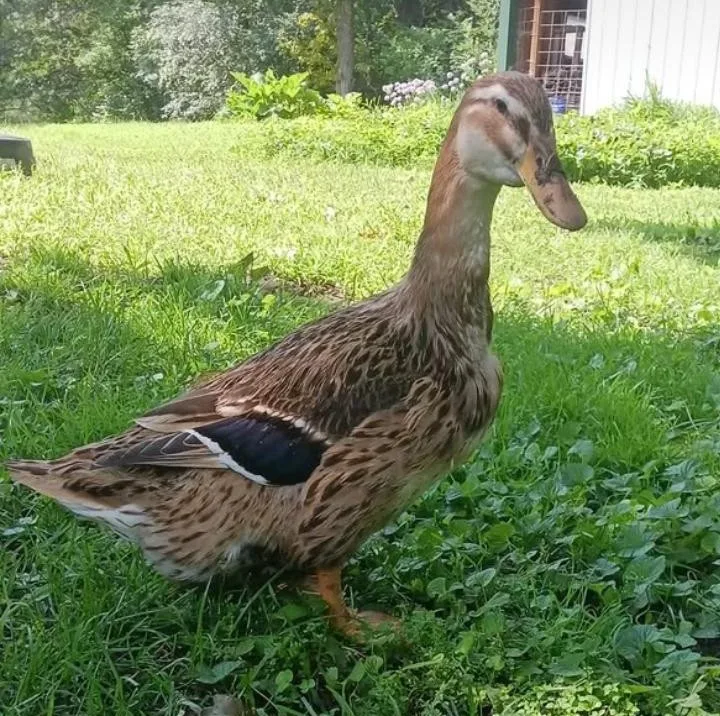
Silver Bantam
Silver Bantams are small, ornamental ducks that were developed in the UK and are often confused with miniature Appleyards. They weigh just 2–2.5 pounds and are kept mostly for their charming appearance and calm temperament. They lay around 60–100 small white eggs per year and can be a nice addition to hobby flocks. Because of their size, they need extra predator protection and secure housing. These ducks are also a conservation priority and are relatively rare outside the UK.
Swedish (Blue, Black, or Splash)
Swedish ducks are medium-sized, cold-hardy birds known for their calm nature and attractive coloration—usually blue or black with a white bib. They lay 120–180 eggs per year and do well in backyard settings with other breeds. Swedish ducks are good foragers, relatively quiet, and easy to manage. Their eggs are usually white or tinted and they rarely go broody. Though they’re not very common, they’re appreciated for both ornamental and utility purposes.
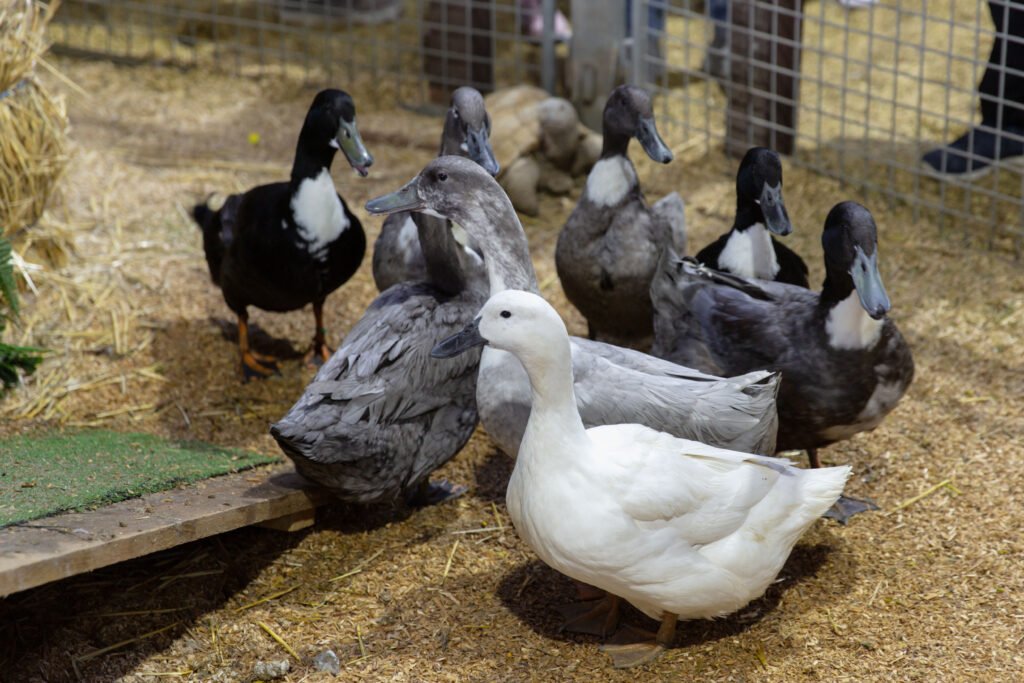
Welsh Harlequin
Welsh Harlequins are one of the most well-rounded duck breeds: they are prolific layers (250–300 eggs/year), beautiful, and friendly. Their plumage features soft, warm tones of cream, gold, and sage-green, with sex-linked coloration making it easy to tell males and females apart at hatch. They’re active foragers, great for free-range environments, and generally mild-tempered. Welsh Harlequins are also known for being good brooders compared to other egg-focused breeds. They thrive in moderate climates with some shade.
👉 Read our Welsh Harlequin Duck profile →

White Layer
The White Layer is a hybrid duck developed specifically for high egg production, capable of laying 290–330 white eggs per year. These ducks are lightweight, alert, and excellent for backyard keepers who prioritize eggs over aesthetics or meat. While not a recognized heritage breed, they’re incredibly efficient and perform well in a range of climates. They’re active and need plenty of stimulation to prevent boredom. Their pure white appearance and slender build resemble a lighter Pekin.
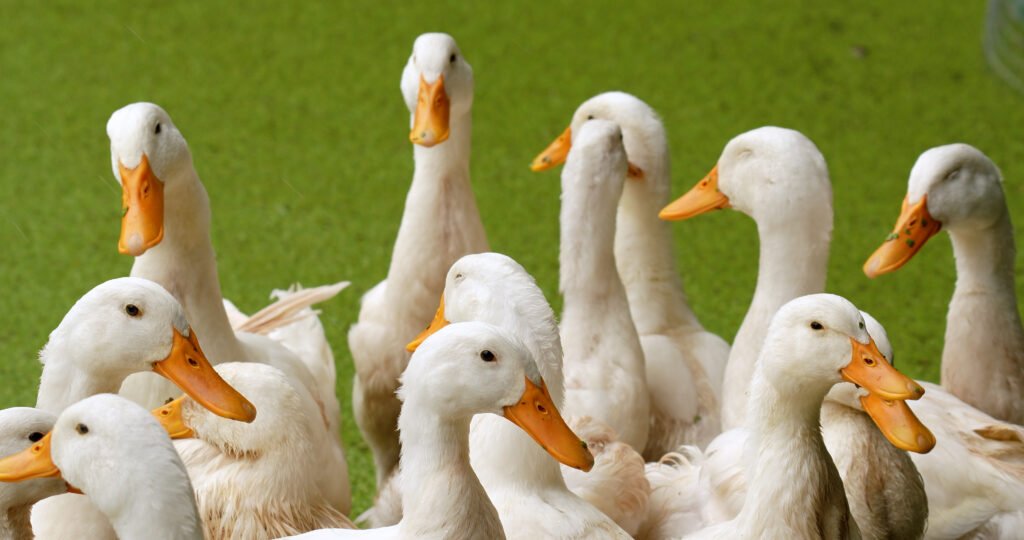
Mallard-Derived Ducks vs. Muscovy Ducks
Understanding the difference between duck types is essential when choosing breeds for your flock. Most domestic duck breeds, including popular choices like the Pekin, Indian Runner, Welsh Harlequin, and Cayuga, are descended from the wild Mallard (Anas platyrhynchos). These breeds share similar reproductive traits and can interbreed with each other easily. They also tend to have similar behavioral patterns, such as quacking, dabbling in water, and limited flight ability, depending on their body structure.
In contrast, Muscovy ducks (Cairina moschata) are a completely different species. They originate from Central and South America and are genetically distinct from Mallard-derived ducks. Muscovies don’t quack—instead, they make soft hissing sounds—and they are much quieter overall. They also have sharp claws, a preference for roosting on elevated surfaces, and much stronger flight capabilities. If you keep both types together, it’s generally fine, but be aware that their hybrid offspring—known as mule ducks—are sterile. For anyone hoping to breed their ducks, it’s best to either stick with Mallard-type breeds or separate Muscovies during the breeding season.
How to Choose the Right Duck Breed
Choosing the right duck breed depends on a variety of factors, and there’s no one-size-fits-all answer. Your first step is to determine the primary purpose of your flock. If you’re keeping ducks primarily for eggs, then breeds like Khaki Campbells, Indian Runners, and Welsh Harlequins are ideal because of their high production and reliable laying cycles. If companionship is more important to you, consider calmer, more docile breeds like the Cayuga, Buff Orpington, or Pekin. Their gentle temperaments and affectionate behavior make them wonderful pets.
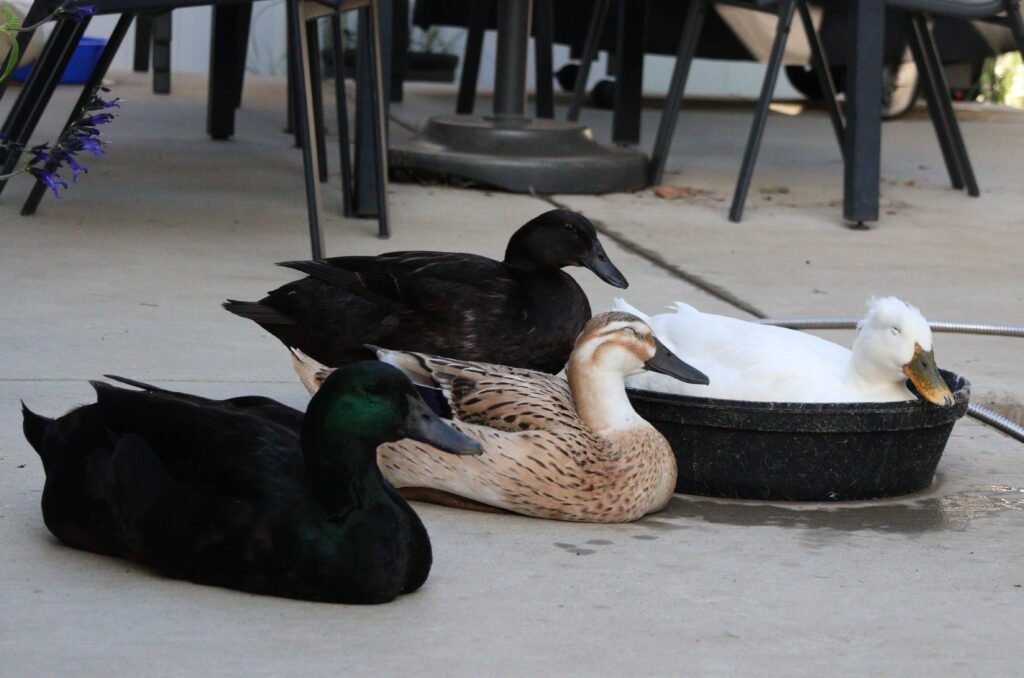
Some keepers are drawn to unique appearances or conservation goals. Breeds like the Silver Appleyard, Ancona, and Magpie offer striking plumage patterns and are often part of preservation programs. Others may prioritize meat production, in which case large-bodied ducks like the Rouen, Muscovy, or Pekin are more suitable. Additionally, take your environment into account. Certain breeds handle cold or hot weather better than others, and some are more prone to broodiness or flying. Think about the space you have, whether you plan to free-range, and how much interaction you want with your birds. All of these considerations play a role in finding the right breed—or mix of breeds—for your needs.
Keeping Multiple Duck Breeds Together
It’s entirely possible to keep multiple duck breeds together in one flock, and many backyard duck keepers enjoy the variety that comes with a mixed group. Ducks are social animals that generally get along well, especially if they’re raised together from a young age or introduced slowly and thoughtfully. Different breeds will form bonds, share space, and forage side by side without issue. They’ll also tend to follow the same daily rhythms—bathing, preening, nesting—regardless of differences in size or temperament.
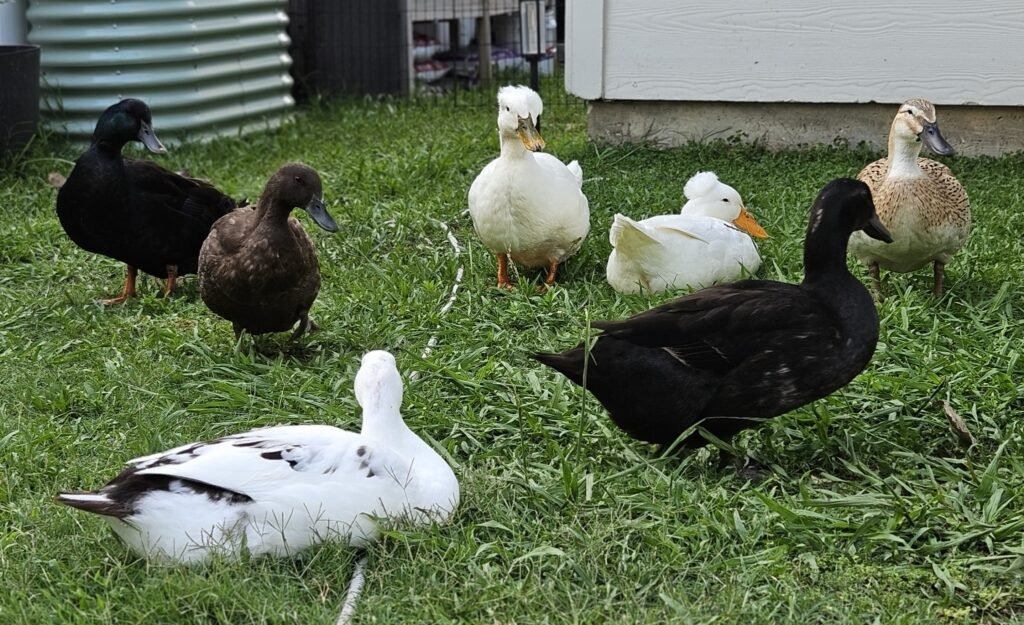
However, breed size should be considered when mixing ducks. Extra-large breeds like Muscovies or Jumbo Pekins can unintentionally harm smaller breeds, especially bantam ducks like Calls or Silver Bantams. Injuries can occur during rough mating behavior or even in everyday jostling if the size difference is extreme. If you plan to mix vastly different-sized ducks, it’s safest to supervise closely or house them separately during the breeding season. Most other combinations will live peacefully together, especially when provided with plenty of space, enrichment, and a stable flock dynamic.
Flock Ratios: How Many Drakes Per Hen?
Flock harmony depends not only on breed choice but also on the number of males, or drakes, you keep. A common mistake among new duck owners is having too many drakes in a small flock, which can lead to aggressive mating behavior, feather damage, and serious stress or injury to females. Ducks have a strong mating drive, especially in the spring and summer, and drakes can quickly overwhelm hens if the ratios are off.
The ideal drake-to-hen ratio for most backyard flocks is one drake for every four to six hens. This allows for natural flock behavior while preventing excessive attention to any one female. In flocks with only a few hens, it’s often best to avoid keeping a drake at all unless breeding is your goal. Some drakes can live peacefully in all-male flocks as long as they have enough space and no females nearby to compete over. Watching your flock dynamics closely is essential—every duck has its own personality, and what works for one setup may need adjusting in another.
Where to Get Ducks
Once you’ve decided on the right breed or breeds for your flock, the next step is finding a trustworthy source. Reputable hatcheries are a great option for a wide selection of breeds, particularly if you’re starting with ducklings. Hatcheries like Metzer Farms, Meyer Hatchery, or Cackle Hatchery offer healthy birds and often ship across the U.S. If you prefer to see your ducks in person before bringing them home, check for local breeders or small farms that specialize in the breeds you’re interested in. These sources can often offer more individualized care and better socialization, especially for pet-focused flocks.
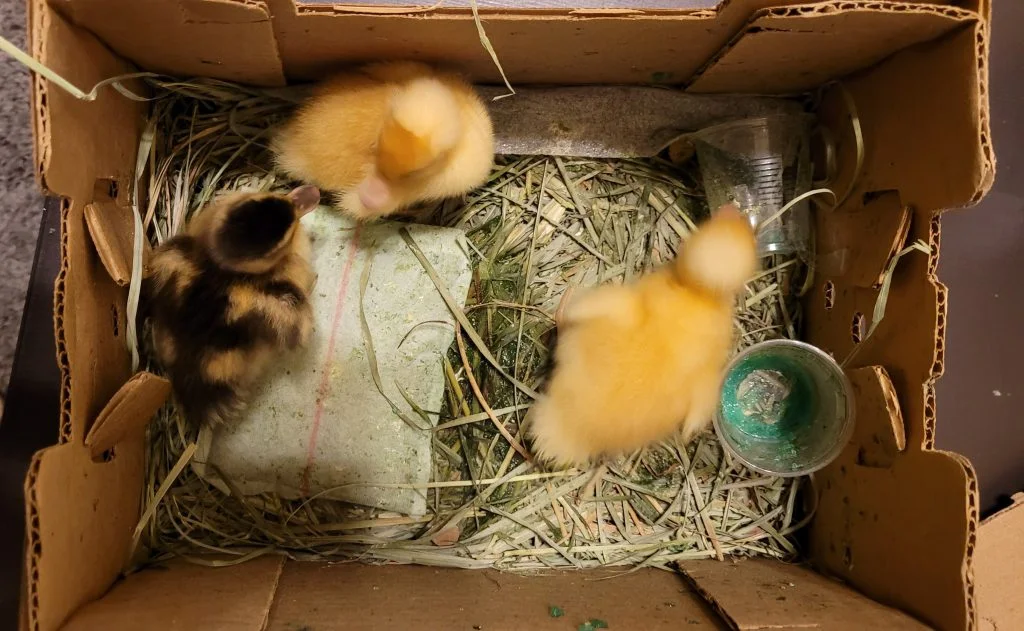
Another excellent option is adopting from a rescue or rehoming network or a sanctuary. Many ducks are surrendered due to a lack of preparation or changes in their owners’ lives, and these birds are often healthy and ready for loving homes. No matter where you get your ducks, be sure to ask questions about their age, health history, and breed traits. Avoid buying from sellers who can’t confirm these details, as it can lead to unexpected challenges later on. And always make sure your duck house and run are set up before the ducks arrive—first impressions matter, even for feathered friends.
Quick Summary: What to Know Before Choosing a Duck Breed
- Most domestic ducks come from the Mallard, but Muscovies are a different species with different behaviors and care needs.
- Choose your breed based on your goals—whether that’s egg production, temperament, size, appearance, or meat.
- You can mix duck breeds in one flock, but be cautious when combining very large ducks with bantams.
- Maintain healthy flock dynamics with the right drake-to-hen ratio—ideally one drake for every 4 to 6 hens.
- Get your ducks from reputable hatcheries, breeders, or rescues, and always prepare their housing before bringing them home.
Related Articles
- Pet Ducks: How Many should I have? And where do I get them from?
- Keeping Ducks: A Beginner’s Guide
- The Ultimate Guide to Duck Names: Fun and Creative Ideas for Your Feathered Friend
- Quackonomics 101: Exploring Pet Duck Cost
- How To Get A Duck to Trust You?
- Feeding Ducks: A Guide to Keeping Your Flock Happy and Healthy

